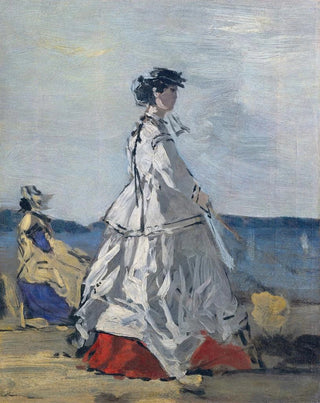Art print La princesse Pauline Metternich sur la plage - Eugène Boudin | Art print


View from behind

Frame (optional)
In the enchanting world of Impressionism, Eugène Boudin stands out for his ability to capture the light and atmosphere of marine landscapes. The artwork "The Princess Pauline Metternich on the Beach" embodies this quest for ephemeral beauty. The scene, bathed in the reflections of a setting sun, transports us to a beach where time seems to stand still. The eye is immediately drawn to the elegant silhouette of the princess, harmoniously blending into the natural setting. This painting does not merely depict an aristocratic figure; it also evokes a moment of grace and serenity, inviting the viewer to escape to a poetic elsewhere.
Style and uniqueness of the work
Boudin's style is characterized by a fluid and luminous painting technique. In "The Princess Pauline Metternich on the Beach," delicate brushstrokes and subtle nuances of color create a vibrant and lively atmosphere. The sea, painted with light touches, appears to dance under the breath of the wind, while the golden sand warms the scene. The composition is skillfully balanced, highlighting the central figure of the princess while integrating the natural elements surrounding her. This artwork is distinguished by its ability to convey emotion, a fleeting impression of beauty. Shadows and lights play a crucial role, accentuating the movement and vitality emanating from this piece. Overall, it is an ode to nature, where every detail contributes to the harmony of the whole.
The artist and his influence
Eugène Boudin, often considered one of the pioneers of Impressionism, paved the way for many artists who followed in his footsteps. Born in 1824 in Honfleur, he was deeply influenced by Norman landscapes and the changing light of the coast. His encounter with Claude Monet, whom he encouraged to paint en plein air, marked a turning point in art history. Boudin was able to capture the very essence of nature, exploring the relationship between man and his environment. His influence is felt in the work of many

Matte finish

View from behind

Frame (optional)
In the enchanting world of Impressionism, Eugène Boudin stands out for his ability to capture the light and atmosphere of marine landscapes. The artwork "The Princess Pauline Metternich on the Beach" embodies this quest for ephemeral beauty. The scene, bathed in the reflections of a setting sun, transports us to a beach where time seems to stand still. The eye is immediately drawn to the elegant silhouette of the princess, harmoniously blending into the natural setting. This painting does not merely depict an aristocratic figure; it also evokes a moment of grace and serenity, inviting the viewer to escape to a poetic elsewhere.
Style and uniqueness of the work
Boudin's style is characterized by a fluid and luminous painting technique. In "The Princess Pauline Metternich on the Beach," delicate brushstrokes and subtle nuances of color create a vibrant and lively atmosphere. The sea, painted with light touches, appears to dance under the breath of the wind, while the golden sand warms the scene. The composition is skillfully balanced, highlighting the central figure of the princess while integrating the natural elements surrounding her. This artwork is distinguished by its ability to convey emotion, a fleeting impression of beauty. Shadows and lights play a crucial role, accentuating the movement and vitality emanating from this piece. Overall, it is an ode to nature, where every detail contributes to the harmony of the whole.
The artist and his influence
Eugène Boudin, often considered one of the pioneers of Impressionism, paved the way for many artists who followed in his footsteps. Born in 1824 in Honfleur, he was deeply influenced by Norman landscapes and the changing light of the coast. His encounter with Claude Monet, whom he encouraged to paint en plein air, marked a turning point in art history. Boudin was able to capture the very essence of nature, exploring the relationship between man and his environment. His influence is felt in the work of many
12,34 €






